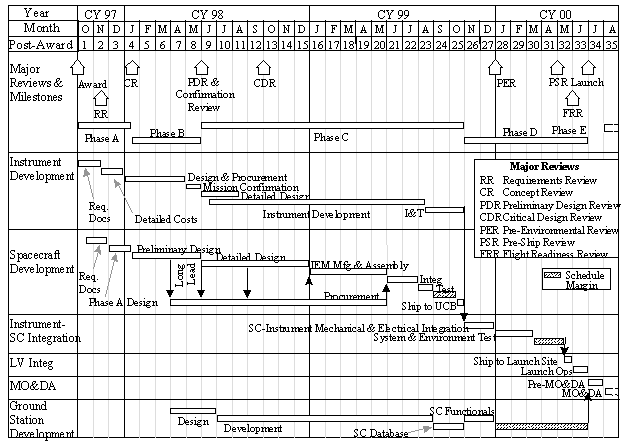G.1. Approach
The HESSI project features a committed team of scientists and an industry partner experienced in small spacecraft efforts.
The Management Organization (Fig. G-1) will be based on that for the UCB FAST/SMEX. The PI will be the point of contact with the SMEX project HESSI Mission Manager. Reporting directly to the PI will be the Project Manager (PM), Mr. Peter Harvey, who will supervise and coordinate the instrument development at UCB, GSFC, and Paul Scherrer Institute (PSI); the spacecraft development at Spectrum Astro, our industry partner; and the ground system development, integration and test, and mission operations preparation at UCB. Following launch, the PI will direct the Mission/Science Operations at UCB, and lead the overall science analysis effort, with support of the Co-Is, the Education/Outreach and the Ground Observations Coordinators.
![]()
The PI will delegate to the PM the responsibility and decision-making authority for the day-to-day operation of the project, with particular emphasis on cost and schedule control. The PM will develop an integrated (UCB, GSFC, PSI, Spectrum Astro) cost and performance report, and provide monthly submissions to the PI and the HESSI Mission Manager. Major decisions regarding cost or performance changes during development will be made by the PI in consultation with the PM and lead Co-Is at GSFC and PSI (and the project manager at Spectrum Astro for spacecraft issues).
The HESSI hardware development team consists of UCB, GSFC, PSI, and Spectrum Astro (Table G-1). UCB was designated as the PI institution and developer of the Spectrometer, based on the solar high-energy (HIREGS, HIREX balloon program) and space-flight experiment expertise (see Appendix I) of Professor Robert Lin, and on the capabilities of the UCB Space Sciences Laboratory (FAST, SOHO XDL, Polar EFI, Wind, EUVE, etc.). GSFC, under lead Co-I Dr. Brian Dennis, was designated to lead the grids and cryocooler effort based on their HEIDI balloon program, their grid characterization expertise, and their cryogenics experience on numerous programs. PSI, under lead Co-I Dr. Alex Zehnder, was chosen for the telescope, RAS, and SAS, based on their experience on XMM, EUVITA, and MIR. Spectrum Astro, our industry partner, was chosen to provide the spacecraft, based on their outstanding record in small spacecraft (MSTI 1,2,3; New Millenium DS-1, MightySat), and their flight-qualified subsystems useful for HESSI.
| Team Member | Role | Relevant Experience |
| UCB | Project Management
Spectrometer Instrument Electronics Flight Software Ground Data System Mission I&T Flight Ops Data distribution |
FAST, Polar, Wind,
HIREGS, TGRS, FAST, HIREGS FAST ITOS FAST, Polar, Wind FAST SOC FAST SOC |
| GSFC | Grid Characterization
Cryogenics Image Analysis Software Solar Data Distribution |
HEIDI
COBE, SHOOT HEIDI, Yohkoh, & OVRO SMM, CGRO, Yohkoh & SOHO |
| PSI | Imager Tube, Grid Trays, and RAS and SAS |
XMM RGS, SRG-EUVITA, & MIR-REM |
| Spectrum | Spacecraft and Mission I&T support |
MSTI-1,-2,-3 MightySat, & New Millenium, DS-1 |
The division of tasks was chosen to take advantage of the strengths of each partner and to provide straightforward, easily manageable interfaces between the team partners. GSFC tests, characterizes, and qualifies the grids and cryocooler, and delivers them to PSI and UCB, respectively. PSI fabricates the telescope, RAS, and SAS, and integrates them with the grids for the complete Imaging System. UCB fabricates the GeDs, cryostat, and instrument electronics, and integrates them with the cryocooler for the complete Spectrometer. These are integrated into the spacecraft fabricated by Spectrum Astro (under contract from UCB), and tested at UCB.
Mission and Science Operations are done at UCB. Data archiving and distribution is done by GSFC for U.S. researchers, and by ETH/Zurich for Europeans.
The top-level mission schedule (Fig. G-2) has a 3-month Concept Phase, a 23-month design and development phase, and 7 months for Mission I&T plus launch site operations. Included are 14 to 16 weeks of distributed slack for instrument and spacecraft, respectively. The instrument schedule of 20 months after concept phase to the start of instrument I&T is achievable with the simplifications itemized in Table H-1. The design has no new technology items, 60% fewer detectors (12 GeDs + 12 SiDs to 9 GeDs), half the electronics, and requires minimal engineering.

The pacing items in the instrument schedule were the cryocooler, the GeDs, and the grids. GSFC has agreed to supply the flight cryocooler immediately from their stock of qualified coolers, for the cost of replacing it. We have already performed GeD compatibility tests with the cooler. Grid characterization facilities are already in place at GSFC and, with fewer grids to fabricate and test, the Imaging System schedule has been improved. UCB technology for HESSI GeDs will be transferred to ORTEC Inc. to speed the fabrication of GeDs. By using the already developed and available spacecraft CPU and memory for instrument functions, instrument flight software development can start immediately.
The spacecraft schedule is based on previous efforts at Spectrum Astro, and is consistent with the design’s maturity.
The ground system schedule is based on FAST. In parallel, the LEO-T ground station will be procured, installed at UCB and tested.
The spacecraft will be tested with the ground system at UCB while the instrument is in test/qual. This provides training time for the Flight Operations Team prior to MSI&T period.